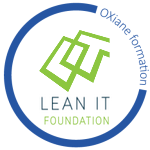Prochaines sessions
Programme
Day 1
- Introduction of Lean
- The Customer
- Exercise WellCare Voice of the Customer
- The Process
- Exercise WellCare SIPOC
Day 2
- Value Stream Mapping
- Exercise WellCare Value Steam Map
- Performance
- Exercise WellCare KPI
Day 3
- The Lean Organization
- Problem Solving with Kaizen
- Behavior and Attitude
- Wrap up and Mock Exam
- Exam
Module 1: Introduction
- Lean principles: how these are related to one another.
- Waste: ability to identify types of waste within an IT organization or process (TIMWOOD with Talent)
- The cost of poor quality and reasons for using Lean Principles to improve performance
- Types of activities: ability to define what IT activities fall into which category
- PDCA: ability to describe how the PDCA cycle works on the most basic level
- Relationship to other models and methods used within IT: understand where Lean IT differs from and complements other methods. The connection of Lean IT with IT service management is specifically investigated.
Module 2: The Customer
- Types of customer value and the factors that influence customer value
- The link between the Voice of the Customer and Critical to Quality
- How to construct a Critical to Quality tree
Module 3: The Process
- Relationship of process (Value stream) with the other Lean principles
- The difference between Push and Pull systems
- The steps for creating a Value Stream Map, using SIPOC and Value Stream Map
- Waste in a Value Stream Map, ability to identify the symbols for the TIMWOOD waste
- Explain the SIPOC and VSM using IT examples e.g. SIPOC: Software development,VSM: High level Change process (other examples are permitted)
Module 4: Performance
- Relationship of performance with the PDCA cycle
- The key aspects of a KPI
- Why time is the most important production factor within IT
- The relationship of PCE with VSM
- The role of skills and knowledge in ensuring performance
Module 5: Organization
- Why organizations need to be customer oriented
- What the goal is of a performance dialogue
- The use of each of the visual management boards – day board, week board andKaizen/improvement board
Module 6: Kaizen
- Which tools from the other dimensions are used in which phase of the DMAIC cycle
- Prioritization of improvement candidates through feasibility and impact in determiningboth which problems to solve with a Kaizen and which solutions to implement at the Improve step of the Kaizen
Module 7: Behavior & Attitude
- The difference between behavior and attitude
- The difference between traditional management and Lean management
- The behavior and attitude required for successful use of Lean
- Behavior and Attitude in relation to expectations surrounding a change in way of working
Evaluation
- The exam is closed-book format
- The exam consists of 50 multiple choice questions
- A minimum score of 75% is required to pass the exam
- The exam lasts 60 minutes

